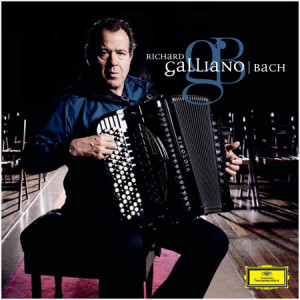ARTIST: Richard Galliano
TITLE: Bach
REVIEWER: Amarillie Ackermann
DATE OF REVIEW: 2011-08-27 09:52:20

TRACKS:
- Badinerie (from Orchestral Suite No. 2 in B Minor, BWV 1067)
- Concerto for Violin, Strings and Continuo in A Minor, BWV 1041
- Air (from Orchestral Suite No. 3 in D Major, BWV 1068)
- Prelude (from Suite for Solo Cello No. 1 in G Major, BWV 1007)
- Concerto for Harpsichord and Strings in F Minor, BWV 1056
- Siciliano (from Sonata for Flute and Harpsichord No. 2 in Eb Major, BWV 1031)
- Allemande (from Partita for Solo Flute in A Minor, BWV 1013)
- Concerto for Oboe, Violin, Strings and Continuo in C Minor, BWV 1060
- Contrapunctus 1 (from The Art of the Fugue, BWV 1080)
- Aria
REVIEW:
Richard Galliano’s CD (Deutsche Grammophon LC 0073) with works by Bach is a masterpiece. Not only technically and musically, but in concept and design as well. The CD contains a beautiful collection of works by Bach, in different arrangements, on different instruments in the accordion family, some are solos, and some are ensemble works with the backing of instruments from all four instruments from the string family. It is a must for any Bach or accordion enthusiast.
The Badinerie from the Orchestral Suite No. 2 in B Minor, is performed on the accordina, together with string ensemble. This is refreshing, as I did not even know the accordina. There is a captivating dialogue between accordina and strings.
The Concerto for Violin, Strings and Continuo in A Minor, complete in 3 movements, is performed on accordion, with string ensemble. The solo violin part is done on accordion. If one didn’t know, it could be an accordion concerto. The fact that the accordion has a built-in accompaniment in the left hand, which is frequently heard, gives an extra dimension. The slow movement (Andante) is one of the most serene and beautiful moments that I have experienced recently. The coupler settings on the accordion are capable of imitating the violin sound very closely.
The famous Air on a G String from the Orchestral Suite No. 3 in D Major, is exquisitely performed on the bandoneon, another beauty in the accordion family, together with string ensemble. The dialogue between the various counter melodies is brought out very clearly between the instruments. For anybody to whom this will be the first introduction to the bandoneon – enjoy the experience.
The Prelude from the Suite for Solo Cello No. 1 in G Major, is the best surprise. It is performed as a solo on the accordion. One is hard pressed to believe that it is not performed on a cello. It is astonishing how close the two instruments sound, and how close Richard Galliano brings the sound of the cello out of the accordion, and also, how closely he performs it exactly as it would be heard on cello. The famous large jumps from the bass notes to the higher notes in semiquavers, can almost not be performed live on the cello without a miniscule audible break. On the accordion, it can, but yet, Richard Galliano retains that slight break, so as to retain the typical feeling. If one hasn’t fallen in love with the accordion yet, then this track could certainly do the trick.
The Concerto for Harpsichord and Strings in F Minor, also with three movements, features the accordion instead of the harpsichord. Although the harpsichord sound can not be imitated on the accordion, the accordion’s sonorous sustain give the famous Largo (Alternative title: Arioso) the beautiful legato sound, which the harpsichord lacks. It is magnificent.
The Siciliano from the Sonata for Flute and Harpsichord No. 2 in Eb Major has another hauntingly beautiful melody. The flute part is performed on violin by Jean-Marc Phillips, and Richard Galliano plays the harpsichord part on the accordion. Although the accordion provides mostly the accompaniment, it also has some countermelodies, which provide a beautiful conversation with the solo violin.
The Allemande from the Partita for Solo Flute in A Minor, is performed on accordion only, as a solo. As was the case with the Prelude from the Suite for Cello, Richard Galliano performs it very closely to the way it would be performed on flute. Of course, one does not hear the characteristic sounds of breathing, as it is not necessary, and the accordion sound does not resemble the flute as closely as it does the cello.
In the Concerto for Oboe, Violin, Strings and Continuo in C Minor, also with 3 movements, Richard Galliano plays the oboe part on the accordion. The violin part is performed by Sebastien Surel. The accordion sounds closest to the oboe of all instruments, as it is already also a reed instrument. It is a fantastic rendition of this beloved double concerto.
The Contrapunctus 1 from the Art of the Fugue, is Richard Galliano’s masterpiece on solo accordion. The voicing that he creates, especially towards the end, makes one believe that you are hearing a gigantic organ, with several different registrations. It sounds like 10 people doing it. It is really difficult to believe that it is done on one small instrument that one can hold on one’s lap, by one master. The quotation on the CD inlay says: “The accordion, a portative organ with vast expressive potential”. That is an understatement.
The last track, called Aria is unknown to me, but it is also on solo accordion, using the portative organ and its vast expressive potential to the maximum. Again, it is almost impossible to believe that it is all done on one accordion. Hearing is trusting, but seeing is believing.
Also featured in the string ensemble are: Jean-Marc Apap on viola, Raphaël Pidoux on cello, and Stéphane Logerot on double bass. The entire string ensemble, together with Richard Galliano form a winning combination, in this magnificent CD of magnificent works, performed magnificently by this Dream Team of artists.
